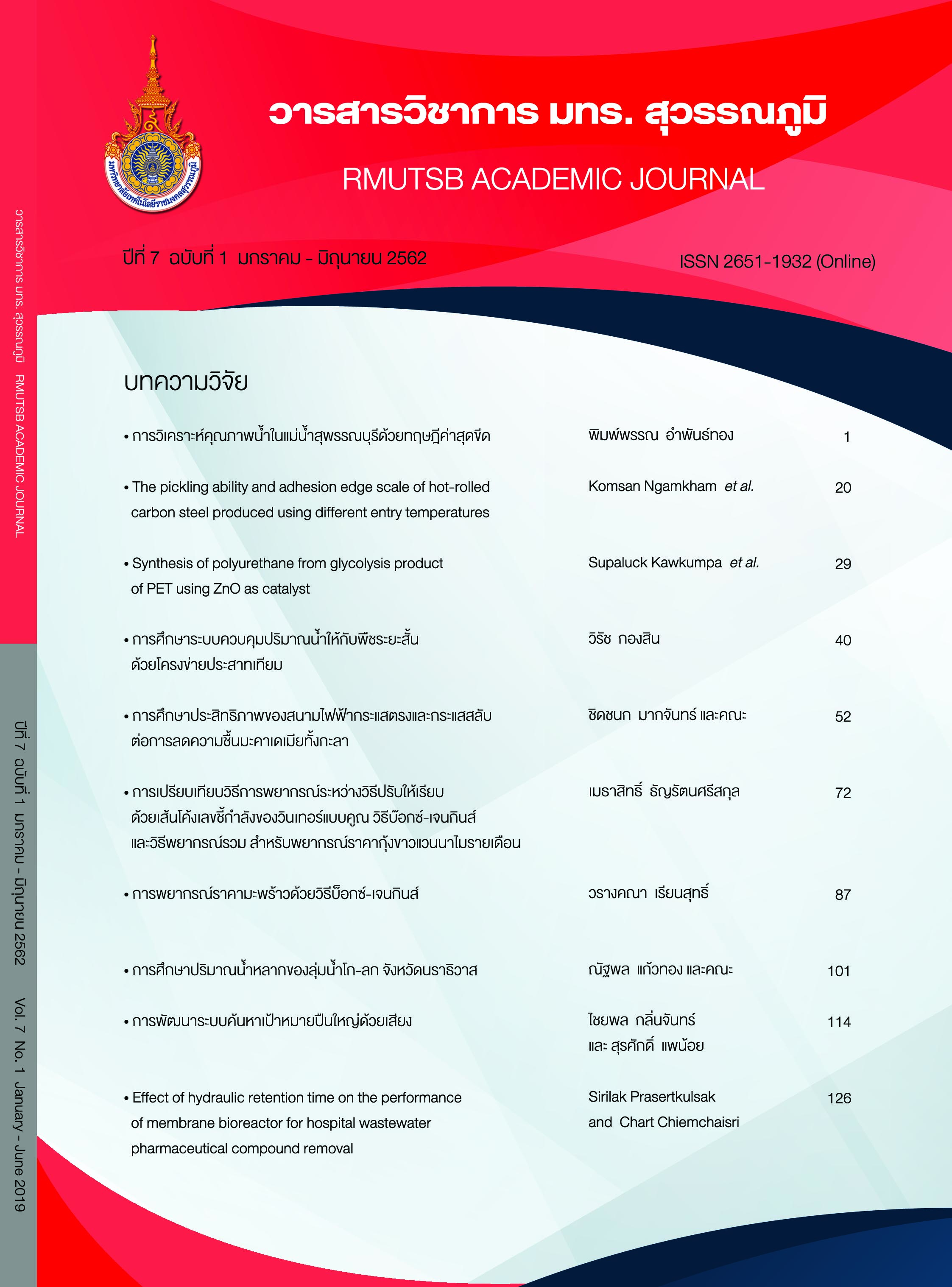Study of water content control systems for short-lived vegetables using neural networks
Main Article Content
Abstract
The purpose of this research was to improve the efficacy of water use in agriculture especially in the areas with limited water sources. This research focused on how to decrease amount of water to the Chinese kale, one of the most popular vegetable plant of Suphanburi, while the crop production was unaffected. The experiments were done in May and June at Samchuk district, Suphanburi province. The variety of Maejo 1 of Chinese kale was used in this research. The seeds were sowed into two beds of size 2×3 meters located in the mosquito net curved roof. The first bed treated the water by using a timer, while the other bed treated the water by using a neural network. For the first bed, after the calculation using Penman-Monteith formula, 26.08 and 21.60 liters of water per day are used in May and June accordingly. However, in the other bed that used a neural network water treatment, the Penman-Monteith formula and data from the sensors every 7 days, are used to forecast the required amount of water. After the calculation, the second bed required less amount of water than the first bed by 53.78 liters per week in May and 51.54 liters per week in June. However, the average weight of the kales produced from two methods were slightly different by 0.02 gram only. Therefore, the neural network could be used to reduce the amount of treatment water.
Article Details
Published manuscript are the rights of their original owners and RMUTSB Academic Journal. The manuscript content belongs to the authors' idea, it is not the opinion of the journal's committee and not the responsibility of Rajamangala University of Technology Suvarnabhumi
References
จำเริญ ยืนยงสวัสดิ์. (2543). หลักการกสิกรรม. สงขลา: ภาควิชาพืชศาสตร์ คณะทรัพยากรธรรมชาติ มหาวิทยาลัยสงขลานครินทร์ วิทยาเขตหาดใหญ่.
ประสิทธิ์ กาบจันทร์. (2557). คู่มือการปลูกคะน้าอินทรีย์(เอกสารเผยแพร่). เชียงใหม่: ฝ่ายนวัตกรรมและถ่ายทอดเทคโนโลยี สำนักวิจัยและส่งเสริมวิชาการการเกษตร มหาวิทยาลัยแม่โจ้.
ประสิทธิ์ เมฆอรุณ. (2558). การพัฒนาระบบสนับสนุนการตัดสินใจด้านการบริหารจัดการน้ำ ในพื้นที่ชลประทาน ด้วยวิธี Penman Monteith กรณีศึกษาฝ่ายส่งน้ำและบำรุงรักษาที่ 1 โครงการส่งน้ำและบำรุงรักษาดงเศรษฐี. วารสารสังคมศาสตร์ มหาวิทยาลัยศรีนครินทรวิโรฒ, 18, 83-95.
พรรณวิภา อรุณจิตต์, นาวี โกรธกล้า, และปิจิราวุธ เวียงจันดา. (2558). โรงเรือนปลูกพืชควบคุมและมอนิเตอร์อัตโนมัติผ่านระบบเครือข่าย. ใน การประชุมวิชาการสมาคมวิศวกรรมเกษตรแห่งประเทศไทยระดับชาติ ครั้งที่ 16 และระดับนานาชาติครั้งที่ 8. กรุงเทพฯ: สมาคมวิศวกรรมเกษตรแห่งประเทศไทย.
พยุง มีสัจ. (2551). ระบบฟัชชีและโครงข่ายประสาทเทียม. กรุงเทพ: คณะเทคโนโลยีสารสนเทศ มหาวิทยาลัยเทคโนโลยีพระจอมเกล้าพระนครเหนือ.
ไพฑูรย์ รื่นสุข. (2547). ข้อมูลเกษตรกรจังหวัดสุพรรณบุรี. สุพรรณบุรี: สำนักงานเกษตรจังหวัด สุพรรณบุรี กรมส่งเสริมการเกษตรกระทรวงเกษตรและสหกรณ์.
ยุพิน ไชยสมภาร, และทวี ชัยพิมลผลิน. (2556). การพยากรณ์ระดับน้ำโดยแบบจำลองโครงข่ายประสาทเทียมด้วยข้อมูลปริมาณน้ำฝนจากแบบจำลอง. วารสารมหาวิทยาลัยศรีนครินทรวิโรฒ (สาขาวิทยาศาสตร์และเทคโนโลยี), 17, 83-90.
วันชัย คุปวานิชพงษ์. (2555). การออกแบบระบบให้ผ่านท่อในงานวิจัยเกษตรวิศวกรรม (เอกสารเผยแพร่). กรุงเทพฯ: กลุ่มพัฒนาพื้นที่เกษตรสถาบัน วิจัย เกษตรวิศวกรรม.
ศุภโชค แสงสว่าง. (2559). การประยุกต์ใช้โครงข่ายประสาทเทียมกับงานด้านการเกษตร. วารสารวิชาการพระจอมเกล้าพระนครเหนือ, 26(2), 319-331.
ศุภัทรษร คำบ่อ. (2556). แบบจำลองการเจริญเติบโตและผลผลิตของถั่วเขียวโดยใช้โครงข่ายประสาทเทียม (วิทยานิพนธ์ปริญญามหาบัณฑิต). มหาวิทยาลัยเทคโนโลยีสุรนารี, นครราชสีมา.
ส่วนการใช้น้ำชลประทาน. (2554). คู่มือการหาปริมาณการใช้น้ำของพืชปริมาณการใช้น้ำของพืชอ้างอิงและค่าสัมประสิทธิ์พืช. กรุงเทพ: สำนักอุทกวิทยาและบริหารน้ำ กรมชลประทาน.
Khoshnevisan, B., Rafiee, S., Omid, M., & Yousefi, M. (2013). Prediction of environmental indices of Iran wheat production using artificial neural networks. Energy and Environmental, 4, 339-348.
Pahlavan, R., Omid, M., & Akram, A. (2012). Energy input-output analysis and application of artificial neural Networks for predicting greenhouse basil production. Energy, 37, 171-176.


